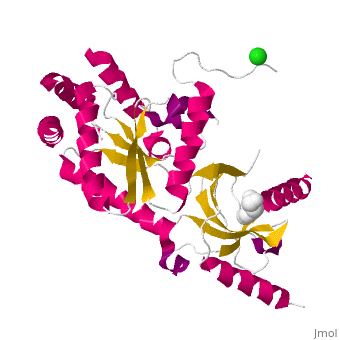Voltage-gated calcium channels
From Proteopedia
IntroductionVoltage-gated calcium channels play crucial roles in many bodily functions including: cardiac action potentials, neurotransmitter release, muscle contraction. During neurological functions, these calcium channels create action potentials[1]. At resting state,voltage-gated calcium channels are in a closed conformation. When the membrane is depolarized, they are open. These channels initiate the release of neurotransmitters at synapses, and have a powerful influence on synaptic strength. The nervous system requires different levels of calcium concentration, so when transmitter release occurs, high levels of calcium are needed. During short-term facilitation, slow steady streams of calcium build up. Failure of these calcium channels can result in migranes, ataxia, and also other neurological diseases. Calmodulin is a specific calcium channel sensor, and regulates the functions of the channel. Calcium binding to calmodulin regulates the facilitation of Ca2+ through the coltage-gated channels.[2] See also Amlodipine and Amiodarone. FunctionThese calcium channels regulate the entry of calcium ions into excitable cells. The isoform alpha-1C gives rise to L-type calcium currents. Long-lasting (L-type) calcium channels belong to the 'high-voltage activated' (HVA) group. They are blocked by dihydropyridines (DHP), phenylalkylamines, benzothiazepines, and by omega-agatoxin-IIIA (omega-Aga-IIIA). They are however insensitive to omega-conotoxin-GVIA (omega-CTx-GVIA) and omega-agatoxin-IVA (omega-Aga-IVA).[3] Calcium channels containing the alpha-1C subunit play an important role in excitation-contraction coupling in the heart. The various isoforms display marked differences in the sensitivity to DHP compounds. Binding of calmodulin or CABP1 at the same regulatory sites results in an opposit effects on the channel function. Some L-type calcium blockers include: dihydropyridines, phenylalkylamines, and benzothiazepines. StructureThis specific protein is a two chain structure and was first found in Rattus norvegicus. The beta-interaction domain (BID), formed the AID-binding site; however, this region is buried in the Ca(V)beta core and is unavailable for protein-protein interactions. The pore-forming α1-subunit of voltage-gated Ca2+ channels (Cav)2 is composed of four homologous domains (I-IV), each of which has six transmembrane segments (S1–S6). When viewed in (where the N-terminus is gradually shaded into the C-terminus according to the scale below)
Channel SignalingThe amount of Ca(2+) entering through these channels is modulated by a plethora of intracellular messenger molecules, including betagamma-subunits of G proteins, and protein kinases.[4] Recent studies show that second messengers and presynaptic vesicle-release proteins don't directly effect calcium activity, but there is definately cross talk between the second messengers and the channel. Pore and Gating StructureVoltage-dependent calcium channels are formed as a complex of several different subunits: α1, α2δ, β1-4, and γ. The α1 subunit forms the ion conducting pore while the associated subunits have several functions including modulation of gating.[5]
3D structures of ion channelsAdditional ResourcesFor additional information, see: Membrane Channels & Pumps
References
| ||||||||||||||||||||
Proteopedia Page Contributors and Editors (what is this?)
Kyle Barrett, Joel L. Sussman, Michal Harel, Alexander Berchansky, David Canner, Eran Hodis

